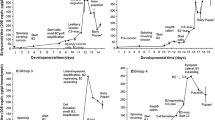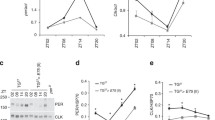Summary
20-hydroxyecdysone (20HE) injections induced transient delays in the time of ecdysis inRhodnius prolixus reared in L/D cycles. Sustained phase delays in the ecdysis rhythm were revealed by transfer to constant dark during the scotophase following 20HE injection. The magnitude of the phase delays depended on the time in the L/D cycle at which 20HE was injected with major delays occurring at times when the endogenous titre is declining. Therefore the increases and decreases in the endogenous titre which are themselves timed in a circadian fashion may be involved in phase setting the ecdysis rhythm to the environmental cycle. Populations maintained in LL which are arrhythmic with respect to both ecdysteroid titres and ecdysis, can be induced to display gated ecdysis by injection of either 20HE or antiserum to ecdysteroids. Multiple injections of 20HE or antiserum are capable of inducing an ecdysis rhythm whose period (22.3 h) and gate location are very similar to that produced by altering the environmental cycle. Therefore manipulations of the endogenous titre of ecdysteroids can mimic the effects of L/D cycles on the timing of ecdysis. Ecdysis inRhodnius may therefore be timed at least partially as a result of circadian timing of the ecdysteroid titre.
Similar content being viewed by others
Abbreviations
- AZT :
-
Arbitrary Zeitgeber Time
- DD :
-
constant darkness
- LL :
-
constant light
- L/D :
-
24 h light dark cycle
- 12L/12D :
-
12 h of light 12 h of dark
- 20HE :
-
20-hydroxyecdysone
References
Ampleford EJ, Steel CGH (1982a) Circadian control of ecdysis inRhodnius prolixus (Hemiptera). J Comp Physiol 147:281–286
Ampleford EJ, Steel CGH (1982b) The behaviour ofRhodnius prolixus (Stål) during the imaginai ecdysis. Can J Zool 60:168–174
Ampleford EJ, Steel CGH (1985) Circadian control of a daily rhythm in haemolymph ecdysteroid titre in the insectRhodnius prolixus (Hemiptera). Gen Comp Endocrinol 59:453–459
Enright JT (1981) Methodology. In: Aschoff J (ed) Handbook of behavioural neurobiology. vol 4. Biological rhythms. Plenum, New York, pp 11–19
Gilbert LI, Goodman W, Bollenbacher WE (1977) Biochemistry of regulatory lipids and sterols in insects. In: Goodwin TW (ed) International review of biochemistry: Biochemistry of lipids II, vol 14. University Park Press, Baltimore, pp 1–50
Kruskal WH, Wallis WA (1952) The use of ranks in one criterion variance analysis. J Am Stat Assoc 47:583–621
Menaker M, Binkley S (1981) Neural and endocrine control of circadian rhythms in the vertebrates. In: Aschoff J (ed) Handbook of behavioural neurobiology, vol 4. Biological rhythms. Plenum, New York, pp 234–255
Pittendrigh CS (1966) The circadian oscillation inDrosophila pseudoobsura pupae: a model for the photoperiodic clock. Z Pflanzenphysiol 54:275–307
Pittendrigh CS (1972) Circadian surfaces and the diversity of possible roles of circadian organization in photoperiodic induction. Proc Natl Acad Sci USA 69:2734–2737
Pittendrigh CS (1981a) Circadian systems: General perspective. In: Aschoff J (ed) Handbook of behavioural neurobiology, vol 4. Biological rhythms. Plenum, New York, pp 57–80
Pittendrigh CS (1981b) Circadian systems: entrainment. In: Aschoff J (ed) Handbook of behavioural neurobiology, vol 4. Biological rhythms. Plenum, New York, pp 95–123
Richter VK (1979) On the effects of ecdysterone on a peripheric motoric nervous activity in the cockroachPeriplaneta americana. Zool Jb Physiol 83:350–360
Ruegg RP, Orchard I, Davey KG (1982) 20-hydroxyecdysone as a modulator of electrical activity in neurosecretory cells ofRhodnius prolixus. J Insect Physiol 28:243–248
Rusak B (1981) Vertebrate behavioural rhythms. In: Aschoff J (ed) Handbook of behavioural neurobiology, vol 4. Biological rhythms. Plenum, New York, pp 183–213
Saunders DS (1979) Insect clocks. Pergamon, Oxford
Slama K (1980) Homeostatic function of ecdysteroids in ecdysis and oviposition. Acta Entomol Bohemoslovaca 77:145–168
Steel CGH, Bollenbacher WE, Smith SL, Gilbert LI (1982) Haemolymph ecdysteroid titres during larval-adult development inRhodnius prolixus: Correlations with moulting hormone action and brain neurosecretory activity. J Insect Physiol 28:519–525
Steel CGH, Davey KG (1985) Integration in the insect endocrine system. In: Gilbert LI, Kerkut GA (eds) Comprehensive insect physiology, biochemistry and pharmacology, vol 8. Pergamon, Oxford, pp 1–35
Truman JW (1981) Interaction between ecdysteroid, eclosion hormone and bursicon titres inManduca sexta. Am Zool 21:655–661
Truman JW, Rountree DB, Reiss SE, Schwartz LM (1983) Ecdysteroids regulate the release and action of eclosion hormone in the tobacco hornwormManduca sexta. J Insect Physiol 29:895–900
Turek FW, Ellis GB (1981) Steroid dependent and steroid independent aspects of the photoperiodic control of seasonal reproductive cycles in male hamsters. In: Follett BK, Follet DE (eds) Biological clocks in seasonal reproductive cycles. John Wright, Bristol, pp 251–260
Author information
Authors and Affiliations
Rights and permissions
About this article
Cite this article
Ampleford, E.J. Ecdysteroids influence the circadian system timing ecdysis in the insectRhodnius prolixus (Hemiptera). J. Comp. Physiol. 157, 699–704 (1985). https://doi.org/10.1007/BF01351363
Accepted:
Issue Date:
DOI: https://doi.org/10.1007/BF01351363




